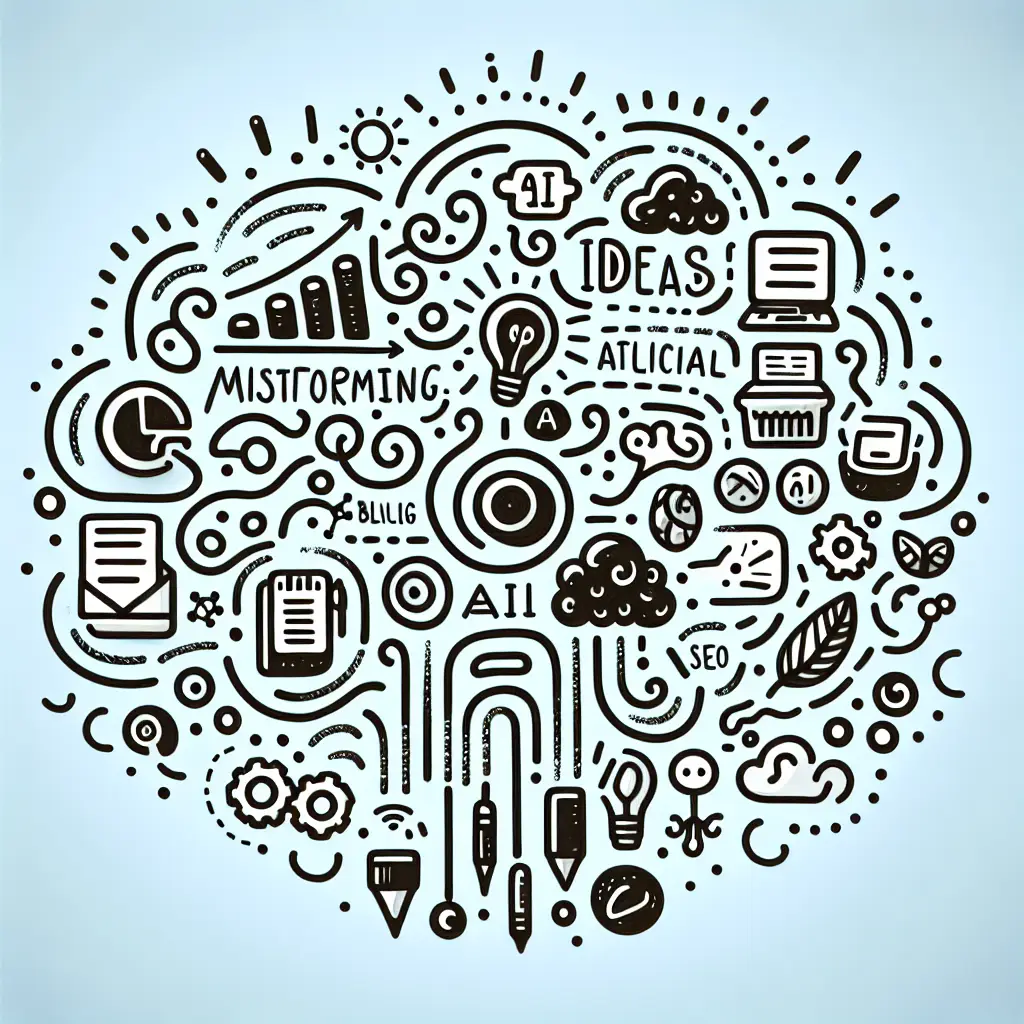Introduction
AI has fundamentally transformed digital marketing, blogging, and copywriting, reshaping how content is created and consumed. The integration of AI technologies into these fields has led to significant advancements, enabling marketers and writers to enhance their productivity and creativity.
The evolution of content creation has been marked by the shift from traditional methods to automated processes. AI tools now assist writers in generating ideas, optimizing content for SEO, and personalizing messages for targeted audiences. This shift not only streamlines the writing process but also improves engagement by delivering tailored content that resonates with readers.
As AI continues to evolve, its role in enhancing the writing process becomes increasingly critical, allowing for more efficient workflows and innovative approaches to storytelling and marketing strategies.

What is AI-Driven Content Creation?
AI-driven content creation refers to the use of artificial intelligence technologies to generate written content. This can include various forms of text, such as blog posts, articles, marketing copy, and social media updates. AI writing tools leverage advanced algorithms to produce content that mimics human writing styles and adheres to specific guidelines or topics.
The capabilities of AI in generating written content are expanding rapidly. These systems can analyze vast amounts of data, understand context, and even learn from previous outputs to improve their writing over time. They can create content that is not only coherent but also tailored to target audiences, making it a valuable asset for marketers, bloggers, and businesses looking to streamline their content strategies.
The technology behind AI writing tools primarily involves machine learning and natural language processing (NLP). Machine learning allows AI systems to learn from data inputs and improve their accuracy and relevance in content generation. NLP enables these systems to understand, interpret, and generate human language in a way that is contextually appropriate and grammatically correct. Together, these technologies make AI-driven content creation a powerful tool in the realm of copywriting and blogging.
For further insights on the role of AI in enhancing communication and content strategies, see our blog on The Future of AI in Digital Marketing.

The Advantages of AI-Driven Content Creation
Increased Efficiency and Speed
AI-driven content creation allows for the ability to create content at scale. Statistics indicate that AI writing tools can generate four times more drafts in the same time as human writers (seosandwitch.com). This efficiency enables businesses to produce more content in less time, meeting the demands of fast-paced digital environments.
Consistent Quality
One of the key advantages of AI in content creation is its ability to maintain content uniformity and language precision across various formats. This consistency is crucial for upholding brand voice, ensuring that AI-generated content aligns with the established tone and style of the organization.
Data-Driven Content Creation
AI can be utilized for keyword optimization and content personalization, which are essential for effectively engaging target audiences. By leveraging insights from user data, businesses can inform their content strategies, tailoring messages to better resonate with their audience’s preferences and behaviors. For more depth on this topic, check out Keyword Optimization in AI Content.
Cost-Effective Solution
Adopting AI tools for content creation can result in lower production costs compared to traditional methods. In the long run, businesses that invest in AI-driven content strategies can experience significant financial benefits, allowing for more resources to be allocated to other critical areas.

How AI Tools Are Enhancing Blogging and Copywriting
AI-Powered Blogging
AI technology has revolutionized the way bloggers create content, particularly through the generation of long-form blog posts. These tools not only produce comprehensive articles but also integrate SEO recommendations to enhance visibility and search ranking. For instance, platforms like OpenAI’s GPT-3 can generate well-structured posts that adhere to SEO best practices, which can save writers significant time and effort.
Several case studies illustrate the success of AI-generated blogs. A notable example is the blog post generated by an AI tool that outperformed human-written content in terms of engagement and shares. This demonstrates the potential of AI to not only assist but also excel in content creation. For more examples on this, refer to our piece on Case Studies in AI-Powered Blogging.
Copywriting for Digital Ads and Social Media
In the realm of digital advertising, AI tools have enabled the automation of short-form copy, streamlining the process of ad creation. AI can also play a crucial role in A/B testing, allowing marketers to adapt advertisements based on real-time performance data. This adaptability ensures that the most effective messages reach target audiences.
For example, AI-generated ad copy has been shown to achieve higher click-through rates compared to traditional methods. Companies employing AI in their ad campaigns have reported significant improvements in engagement metrics, highlighting the effectiveness of AI in crafting compelling advertisements. You can learn more about effective ad strategies in our blog post on AI in Advertising.
AI for Content Research and Idea Generation
AI tools are invaluable for brainstorming new topics and identifying trending themes in real-time. These technologies analyze vast amounts of data to suggest relevant content ideas that resonate with audiences.
Furthermore, AI can assist in competitive analysis by identifying content gaps in a given niche. This enables bloggers and marketers to create unique, targeted content that stands out in a crowded market. Tools like BuzzSumo and SEMrush leverage AI to provide insights that guide content strategy and development.

The Challenges of AI in Content Creation
Authenticity and Reader Engagement
Reader perception of AI-generated content poses a significant challenge in content creation. Many readers can discern when a piece of writing lacks the human touch, which can lead to disengagement. A notable statistic reveals that 52% of readers engage less with a blog post after suspecting it is created by AI (masterblogging.com). This highlights the importance of authenticity in content—readers seek a genuine connection that AI often struggles to provide.
Balancing AI with Human Creativity
While AI can enhance efficiency in content creation, it cannot replace the irreplaceable role of human creativity and emotional intelligence. Crafting compelling narratives requires understanding nuances of human experience that AI may overlook. To effectively integrate AI tools into the writing process, it is crucial to maintain a distinct human touch. Strategies for achieving this balance include:
- Utilizing AI for research and data analysis to inform writing while ensuring the final narrative is crafted by a human.
- Editing and refining AI-generated drafts to incorporate personal insights and emotional depth.
- Engaging in brainstorming sessions that leverage AI for idea generation but rely on human judgment for final content creation.
These strategies help ensure that the content remains engaging and authentic, enhancing the overall reader experience.

Case Studies and Industry Insights
AI in Public Relations
- Overview: 75% of PR professionals are now using generative AI, indicating a significant shift in industry practices (axios.com).
- Examples of successful AI implementation in PR campaigns: Case studies show that AI tools have been utilized to analyze media coverage, predict public sentiment, and automate routine tasks, allowing PR professionals to focus on strategic initiatives.
Impact on Blogging Statistics
- Insights on AI adoption: As of 2025, 80% of bloggers utilize AI for various tasks (masterblogging.com).
- Trends in AI-generated content: AI-generated content now accounts for 12% of all digital content published globally (seosandwitch.com). This trend highlights the growing reliance on AI for content creation and optimization, reshaping the blogging landscape.

How to Leverage AI for Content Creation
Tools and Platforms
AI writing tools have become essential for bloggers and copywriters, offering various features to enhance content creation. Some popular AI writing tools include:
- OpenAI’s GPT-3: Known for its advanced natural language processing capabilities, GPT-3 can generate coherent and contextually relevant text. Pricing varies based on usage, typically requiring a subscription or pay-per-use model.
- Jasper (formerly Jarvis): This tool is designed for marketers and content creators, offering templates and a user-friendly interface. It operates on a subscription model, with plans starting from $29 per month, depending on the features required.
- Copy.ai: Focused on creating marketing copy, Copy.ai provides a range of templates for different content types. It offers a free trial, with paid plans starting at $35 per month.
- Writesonic: This platform includes multiple writing modes, such as blog post generation and ad copy creation. Pricing starts at $15 per month for basic features.
- Grammarly: While primarily a grammar checker, Grammarly also offers writing enhancement suggestions. It has a free tier, with premium plans starting at $12 per month.
When comparing these tools, consider factors such as ease of use, specific features (like SEO optimization or content templates), and pricing models to determine which best fits your needs.
Best Practices for Using AI in Writing
To effectively integrate AI tools into your content strategy, follow these tips:
- Use AI for Inspiration: Leverage AI to brainstorm ideas or generate outlines, but ensure that the final content reflects your unique voice and perspective.
- Edit and Revise: Always review and edit AI-generated content to maintain quality and accuracy. AI can produce errors or misinterpret context.
- Combine AI with Human Insight: Use AI to enhance your writing process but rely on your expertise to add depth and personal touch to the content.
- Stay Updated: Regularly explore new features and updates from AI tools to maximize their potential in your writing process.
Ethical considerations are also crucial when using AI in content creation. Here are some guidelines to use AI responsibly:
- Transparency: Disclose when AI has been used in content creation, especially if it significantly shapes the final piece.
- Avoid Plagiarism: Ensure that AI-generated content is original and does not inadvertently replicate existing works. Use plagiarism checkers to verify content originality.
- Respect Copyright Laws: Be aware of the legal implications surrounding the use of AI-generated content and ensure compliance with copyright regulations.
By following these best practices, you can effectively leverage AI tools while maintaining ethical standards in your writing.

Conclusion
AI has fundamentally transformed content creation, particularly in the realms of copywriting and blogging. Its ability to analyze vast amounts of data and generate human-like text has enabled writers to streamline their processes, create personalized content, and enhance engagement with their audiences. The integration of AI tools in content strategies has not only improved efficiency but has also opened new avenues for creativity, allowing writers to focus on higher-level ideas and storytelling.
Looking ahead, the potential of AI in content creation is immense. As technology continues to evolve, we can expect even more sophisticated tools that will further enhance the writing process. Embracing AI as a partner in creativity can lead to increased productivity and a richer, more diverse landscape of content.
Final thoughts highlight the importance of adapting to these changes. Writers and marketers should view AI not as a replacement but as an invaluable resource that can augment their skills and creativity. By leveraging AI, professionals in the field can elevate their work and stay ahead in an ever-changing digital environment.



